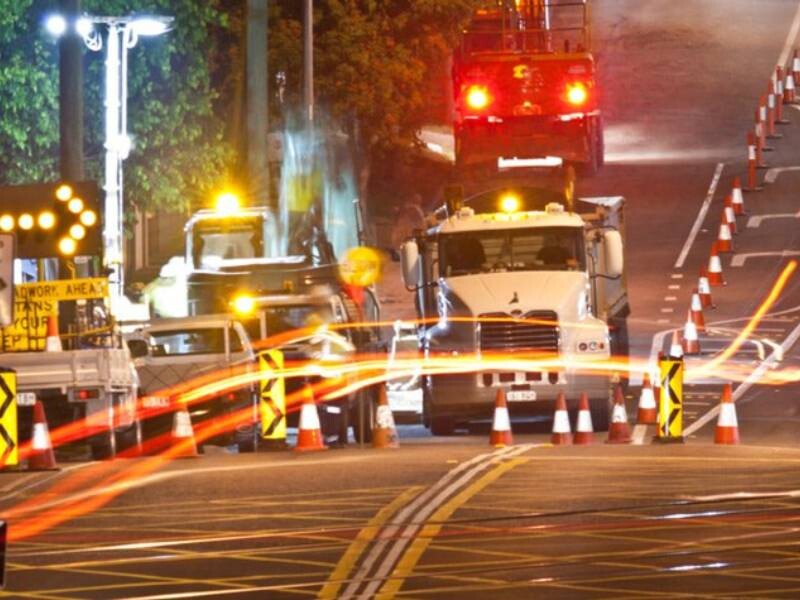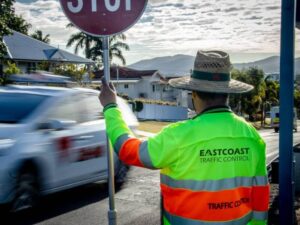When most people think of traffic control, they picture the Stop/Slow bat, the flashing lights, and the cones guiding them through a worksite. But what many don’t realise is that by the time a driver reaches that point, a huge amount of planning and coordination has already taken place.
At East Coast Traffic Control, safety starts long before the first cone hits the road. From behind-the-scenes paperwork to precise site logistics, every detail is carefully managed to ensure the safety of our crews, our clients, and the general public.
Here’s a look at what really happens before you see that Stop/Slow sign.
It all starts with a Traffic Management Plan (TMP)
Every traffic control job — no matter how big or small — begins with an approved Traffic Management Plan.
A TMP is a legally required document that outlines how traffic will be managed during a worksite setup. It includes:
- Diagrams of signage layouts
- Details of detours or lane closures
- Pedestrian access provisions
- Emergency access routes
- Timeframes and conditions
- Compliance with relevant standards (like TMR or TfNSW)
We work closely with councils, contractors and state authorities to ensure the plan is compliant, practical and signed off before any work begins.
Site assessments and risk reviews
Once the TMP is approved, our team gets to work planning the job on the ground. That usually starts with a site inspection — either virtually through mapping systems or physically on location.
We assess:
- Road width and shoulder conditions
- Visibility and line of sight
- Speed zones and traffic flow
- Entry/exit points for vehicles
- Environmental factors (trees, drains, poles, etc.)
This helps us determine what vehicles, signage, and equipment are needed to match the unique conditions of the site.
Gear up: Vehicles, signage and safety equipment
The next step is logistics.
Depending on the scale of the project, our operations team allocates the right combination of:
- Cone Deployment Trucks
- Utes with arrow boards
- VMS trailers
- Signage packs
- Bollards, barriers and taping
- Portable traffic lights (if required)
- Radios, PPE, lighting and emergency gear
Each item is checked, packed and loaded by our depot crew — and nothing leaves the yard without a compliance check.
Crew allocations and job briefing
Our scheduling team then allocates the right crew for the job.
We consider:
- Qualifications (Accredited TCs or TMIs)
- Experience with similar setups
- Travel distance and fatigue management
- Familiarity with the region
Before deployment, each team receives a job briefing. This includes the TMP, site map, client instructions and any special hazards or conditions to be aware of.
Pre-start checks and communication setup
Once on-site, the crew runs through a pre-start process. This is a critical step in ensuring everyone is on the same page before the work begins.
The pre-start covers:
- Roles and responsibilities for the day
- Site-specific hazards
- Radio comms check
- Emergency procedures
- PPE compliance
- Timing for staging or moving setups
Only once all checks are complete do we begin the physical setup.
Setup staging: Safety comes first
Depending on the job, setups might be staged to maintain live traffic flow. For example, signage and cones are placed in advance, often under escort, and lanes are only closed when all safety provisions are in place.
This might include:
- Deploying the VMS board days ahead
- Setting up warning signs in both directions
- Creating safe pedestrian detours
- Allowing time for public notification (in councils or urban areas)
Only after this does the Stop/Slow setup begin — the most visible part of the job, but certainly not the start.
Ongoing monitoring and adjustments
Even after the setup is in place, our work continues. Crew leaders and TMIs monitor the site, report back to operations, and make real-time adjustments if needed.
This could include:
- Moving signage if visibility changes
- Updating VMS messaging
- Coordinating with site supervisors or emergency services
- Rotating controllers to manage fatigue
Our goal is always to stay one step ahead and maintain a safe, flowing worksite from start to finish.
A well-run setup makes all the difference
By the time a driver slows down at the Stop sign, most of the heavy lifting has already been done. The planning, preparation and professionalism behind the scenes is what ensures traffic control doesn’t just look safe — it is safe.
That’s the ECTC difference. We don’t just show up. We show up ready.
FAQs
What is a TMP and who approves it?
A Traffic Management Plan is a document outlining how traffic will be managed during a project. It must be prepared and submitted for approval by the relevant road authority (e.g. TMR or local council) before work starts.
Do all jobs need a site inspection beforehand?
Yes. We assess every site either physically or virtually to plan for hazards, layout, and logistics. This ensures we arrive prepared and compliant.
How long does it take to set up traffic control?
It varies. Some setups take under an hour, while more complex sites with detours or signal adjustments can take several hours — especially if staged across multiple lanes or directions.
What happens if conditions change on the day?
Our crews are trained to adapt on-site and are supported by operations staff who can adjust plans, redeploy gear, or update messaging in real time.
Do you supply your own gear and vehicles?
Yes. ECTC has a full fleet of vehicles, signage, cones, VMS trailers and safety gear ready to go from multiple depots across QLD and NSW.





